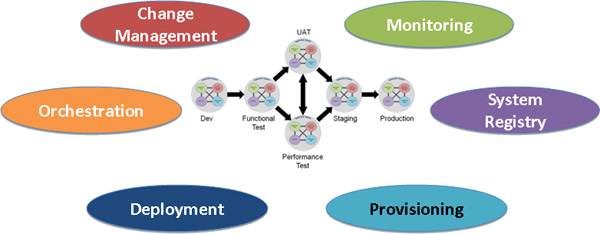The first step to understanding the framework is to define the broad, top level capability areas. A very common problem in technology is the frequent over-use of terms that can have radically different meanings depending on the context of a conversation. So, as with any effort to clarify the discussion of a topic, it is very critical to define terms and hold to those definitions during the course of the discussion.
At the top level of this framework are six capability groupings
- Change Management – This category is for capabilities that ensure that changes to the system are properly understood and tracked as they happen. This is a massively overused term, but the main idea for this framework is that managing changes is not the same thing as applying them. Other capabilities deal with that. This capability category is all about oversight.
- Orchestration – This category deals with the ability to coordinate activity across different components, areas, and technologies in a complex distributed application system in a synchronized manner
- Deployment – This category covers the activities related to managing the lifecycles of an application systems’ artifacts through the various environments. Put more simply this area deals with the mechanics of actually changing out pieces of an application system.
- Monitoring – The monitoring category deals with instrumenting the environment for various purposes. This instrumentation concept covers all pieces of the application system and provides feedback in the appropriate manner for interested stakeholders. For example, capacity usage for operations and feature usage for development.
- System Registry – This refers to the need for a flexible and well-understood repository of shared information about the infrastructure in which the application system runs. This deals with the services on which the application system depends and which may need to be updated before a new instance of the application system can operate correctly.
- Provisioning – This capability is about creating and allocating the appropriate infrastructure resources for an instance of the application system to run properly. This deals with the number and configuration of those resources. While this area is related to deployment, it is separate because in many infrastructures it may not be desireable or even technically possible to provision fresh resources with each deployment and linking the two would blunt the relevancy of the framework.
The next few posts will dig into the sub-categories underneath each of these top-level items.

